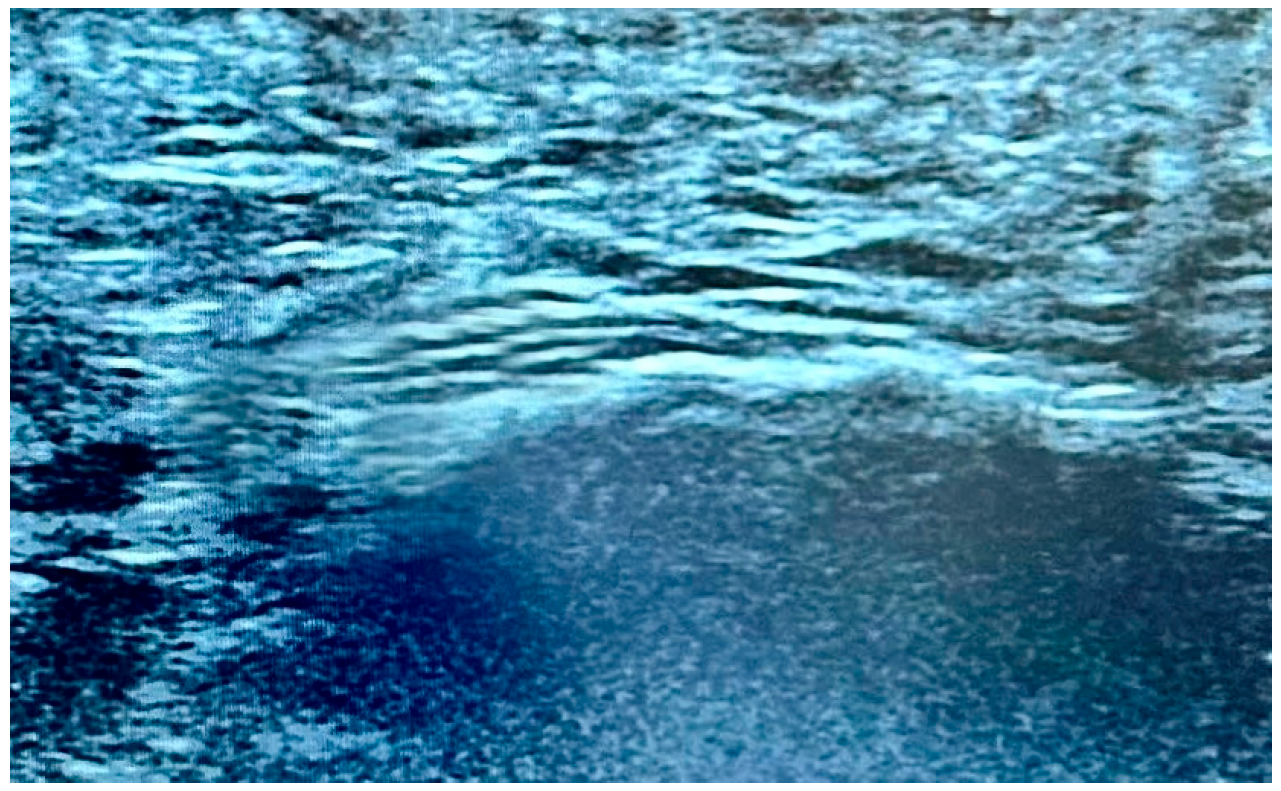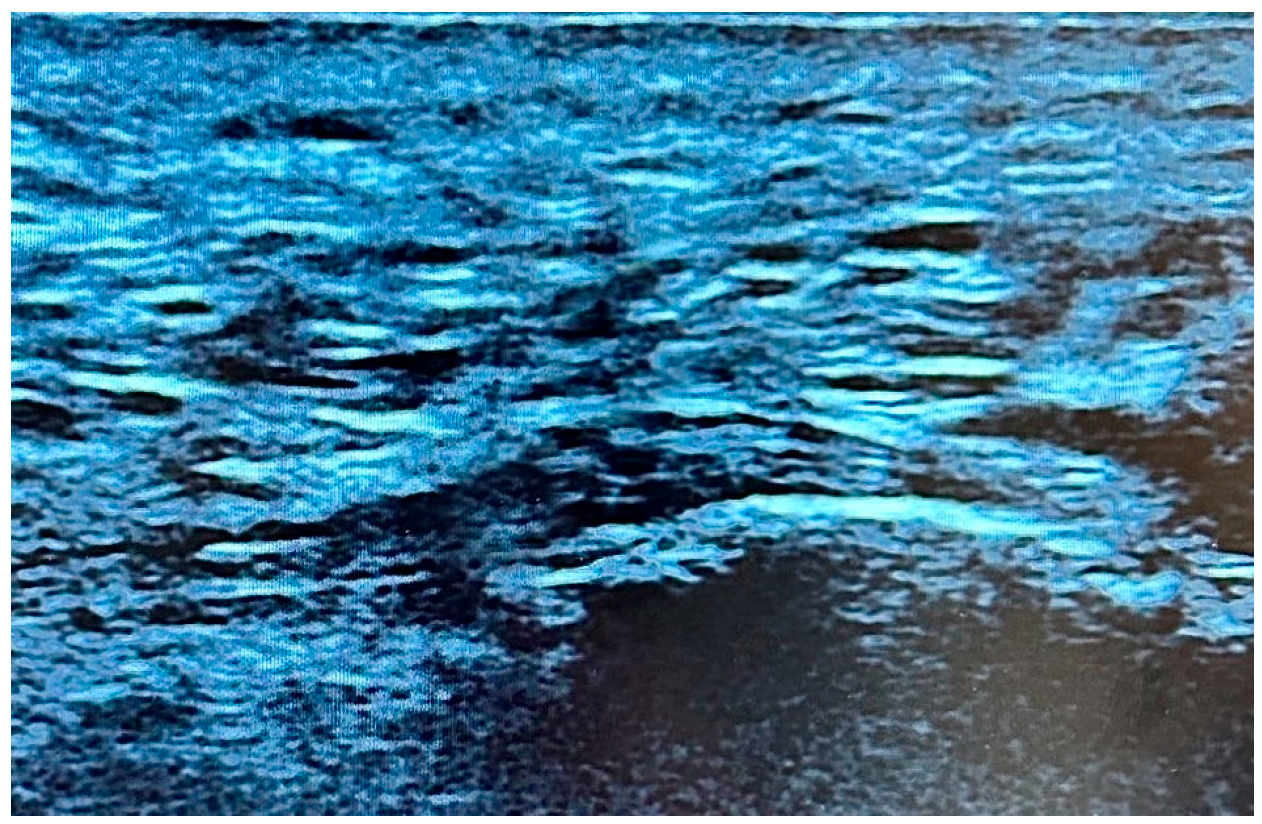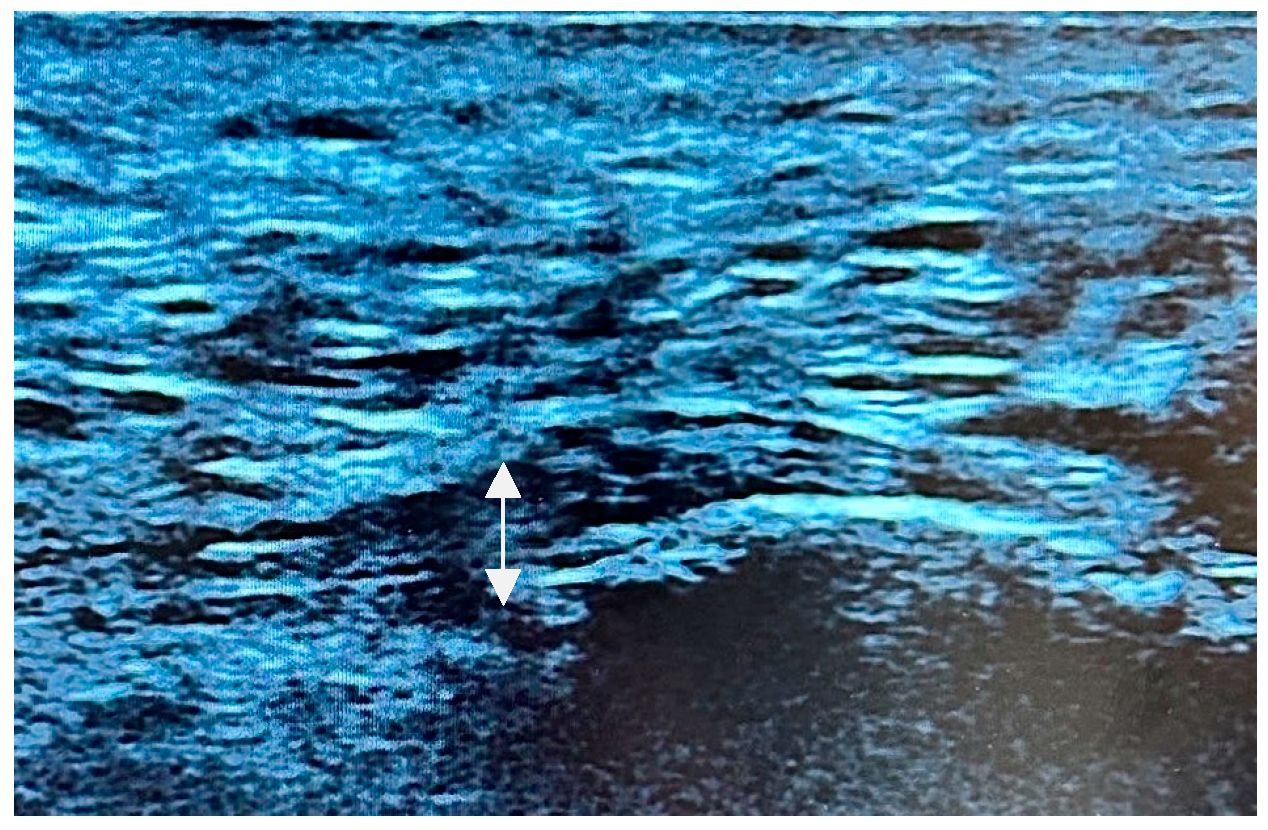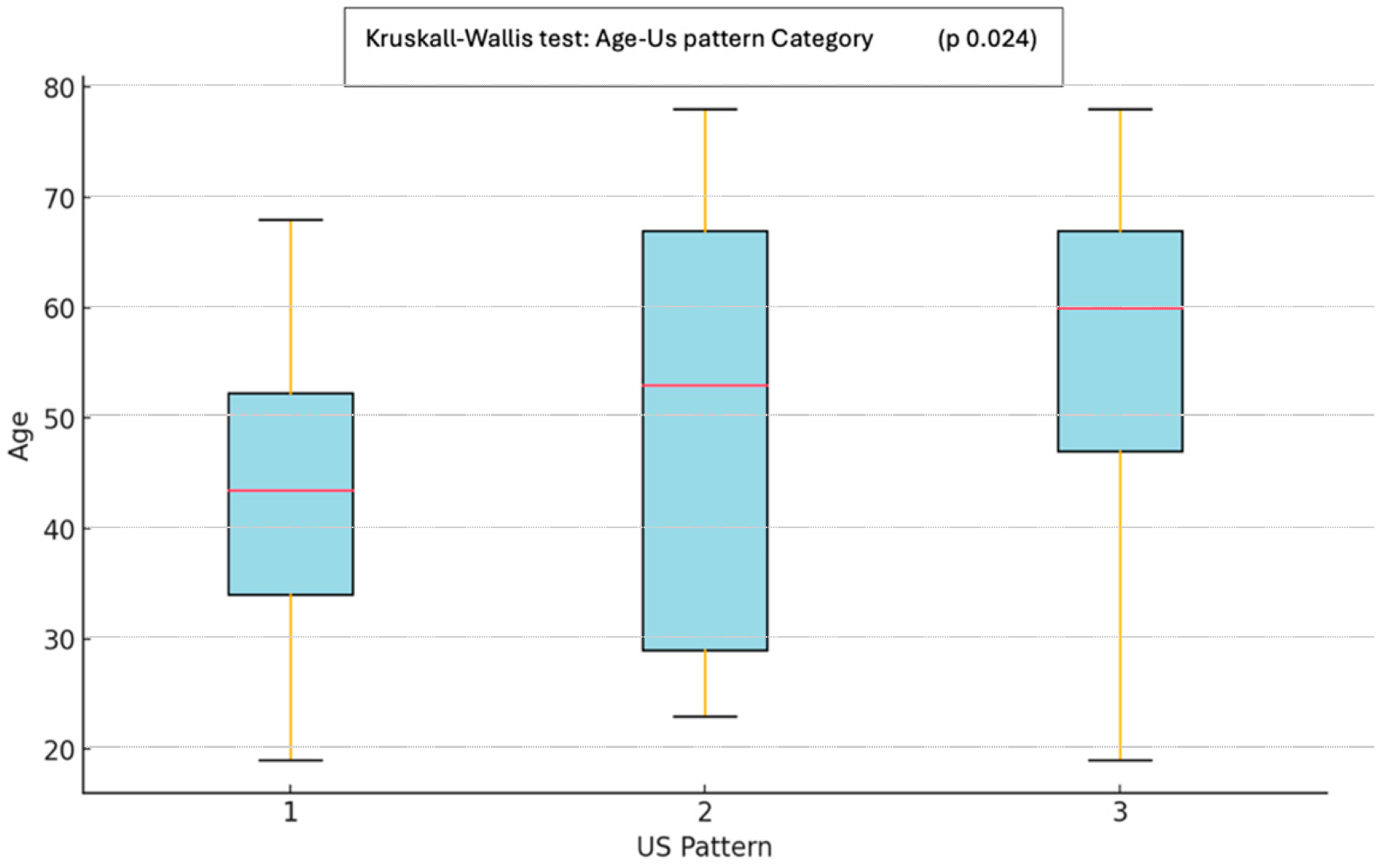Ultrasound Evaluation of Plantar Fascia in Individuals with Charcot–Marie–Tooth Disease: An Exploratory Study
Abstract
1. Introduction
2. Materials and Methods
2.1. Population and Study Protocol
- •
- Adult individuals aged 18 years or older with a certified diagnosis of CMTd;
- •
- Attendance at the CMTd ambulatory as part of routine clinical care;
- •
- Ability to perform gait and standing balance assessments.
- •
- Presence of other diagnosed peripheral neurological disorders;
- •
- Lack of prior consent for the use of biological data for scientific purposes.
2.2. Clinical Scales
- -
- Charcot–Marie–Tooth Examination Score (CMTES) [15]: A clinician-administered scale based on a physical examination that measures motor and sensory impairments. This is a sub-score of the CMT Neuropathy Score [15]. The scale ranges from 0, as healthy status, to 28, indicating a severe condition. The assessment is based on both symptoms and clinical signs. The scale is employed for the purpose of disease severity classification, with the severity of the disease being categorized as follows: mild (score 0–7), moderate (8–14), or severe (>15).
- -
- Tinetti Performance-Oriented Mobility Assessment [16]: A performance-based test used to evaluate balance and gait. Lower scores have been shown to be indicative of poorer balance and higher fall risk. It has previously been demonstrated that this scale is a valid instrument for subjects with CMTd [17], with a strong negative correlation between the Tinetti scale and the severity of the disease.
- -
- Walk-12 Questionnaire: A self-reported measure, used to assess the perceived impact of neuropathy on walking ability [18]. Scores within this scale range from 0, indicating no limitation, to 60, indicating a severe limitation. The measure was originally developed as a disease-specific tool. Holland and colleagues demonstrated the reliability and sensitivity of the test in detecting walking impairments across various neurological conditions, including CMTd [19].
- -
- Short Physical Performance Battery (SPPB): A composite test that evaluates lower extremity function through a series of assessments, including balance, gait speed, and the chair stand test [20]. Scores within this system range from 0 to 12, with higher scores indicating superior physical performance. A previous study has employed SPPB on subjects with CMTd, validating its reliability and relevance as an outcome measure in this population [21].
- -
- 10 Meter Walk Test (10 MWT): A functional walking test in which participants are requested to walk 10 m at a self-selected pace [22]. The speed of walking is measured in meters per second (m/s).
2.3. Instrumental Evaluation



2.4. Statistical Analysis
3. Results
4. Discussion
5. Conclusions
Supplementary Materials
Author Contributions
Funding
Institutional Review Board Statement
Informed Consent Statement
Data Availability Statement
Acknowledgments
Conflicts of Interest
Abbreviations
| CMT | Charcot–Marie–Tooth |
| CMTd | Charcot–Marie–Tooth disease |
| US | Ultrasound |
| CMTES | Charcot–Marie–Tooth Examination Score |
| SPPB | Short Physical Performance Battery |
| 10 MWT | 10 Meter Walk Test |
References
- Barreto, L.C.; Oliveira, F.S.; Nunes, P.S.; de França Costa, I.M.; Garcez, C.A.; Goes, G.M.; Neves, E.L.; de Souza Siqueira Quintans, J.; de Souza Araújo, A.A. Epidemiologic Study of Charcot-Marie-Tooth Disease: A Systematic Review. Neuroepidemiology 2016, 46, 157–165. [Google Scholar] [CrossRef]
- Pisciotta, C.; Bertini, A.; Tramacere, I.; Manganelli, F.; Fabrizi, G.M.; Schenone, A.; Tozza, S.; Cavallaro, T.; Taioli, F.; Ferrarini, M.; et al. Clinical spectrum and frequency of Charcot-Marie-Tooth disease in Italy: Data from the National CMT Registry. Eur. J. Neurol. 2023, 30, 2461–2470. [Google Scholar] [CrossRef]
- Fridman, V.; Bundy, B.; Reilly, M.M.; Pareyson, D.; Bacon, C.; Burns, J.; Day, J.; Feely, S.; Finkel, R.S.; Grider, T.; et al. Inherited Neuropathies Consortium CMT subtypes and disease burden in patients enrolled in the Inherited Neuropathies Consortium natural history study: A cross-sectional analysis. J. Neurol. Neurosurg. Psychiatry 2015, 86, 873–878. [Google Scholar] [CrossRef]
- Pogemiller, K.; Garibay, E.; Pierz, K.; Acsadi, G.; Õunpuu, S. Comparison of gait patterns and functional measures between Charcot-Marie-Tooth disease type I and II in children to young adults. Gait Posture 2020, 77, 236–242. [Google Scholar] [CrossRef]
- Blouin, C.; Perrier, A.; Denormandie, P.; Genêt, F. Relationship between care pathway features and use or non-use of orthotic devices by individuals with Charcot-Marie-Tooth disease: A cross-sectional, exploratory study. Disabil. Rehabil. 2024, 46, 2155–2165. [Google Scholar] [CrossRef]
- Rosenbaum, A.J.; Lisella, J.; Patel, N.; Phillips, N. The cavus foot. Med. Clin. N. Am. 2014, 98, 301–312. [Google Scholar] [CrossRef]
- Jacobs, A.M. Pes Cavus Deformity: Anatomic, Functional Considerations, and Surgical Implications. Clin. Podiatr. Med. Surg. 2021, 38, 291–302. [Google Scholar] [CrossRef]
- Bernasconi, A.; Cooper, L.; Lyle, S.; Patel, S.; Cullen, N.; Singh, D.; Welck, M. Pes cavovarus in Charcot-Marie-Tooth compared to the idiopathic cavovarus foot: A preliminary weightbearing CT analysis. Foot Ankle Surg. Off. J. Eur. Soc. Foot Ankle Surg. 2021, 27, 186–195. [Google Scholar] [CrossRef] [PubMed]
- van Poppel, D.; van der Worp, M.; Slabbekoorn, A.; van den Heuvel, S.S.P.; van Middelkoop, M.; Koes, B.W.; Verhagen, A.P.; Scholten-Peeters, G.G.M. Risk factors for overuse injuries in short- and long-distance running: A systematic review. J. Sport Health Sci. 2021, 10, 14–28. [Google Scholar] [CrossRef] [PubMed]
- Di Caprio, F.; Gigli, M.; Ponziani, L. Plantar fasciitis: A literature review. J. Orthop. Trauma Rehabil. 2025. [Google Scholar] [CrossRef]
- Piarulli, L.; Mathew, R.; Siegler, S. Contribution of the plantar fascia and long plantar ligaments to the stability of the longitudinal arch of the foot. J. Biomech. 2024, 176, 112373. [Google Scholar] [CrossRef]
- Mohseni-Bandpei, M.A.; Nakhaee, M.; Mousavi, M.E.; Shakourirad, A.; Safari, M.R.; Vahab Kashani, R. Application of ultrasound in the assessment of plantar fascia in patients with plantar fasciitis: A systematic review. Ultrasound Med. Biol. 2014, 40, 1737–1754. [Google Scholar] [CrossRef]
- Rhim, H.C.; Kwon, J.; Park, J.; Borg-Stein, J.; Tenforde, A.S. A Systematic Review of Systematic Reviews on the Epidemiology, Evaluation, and Treatment of Plantar Fasciitis. Life 2021, 11, 1287. [Google Scholar] [CrossRef] [PubMed]
- Mori, L.; Prada, V.; Signori, A.; Pareyson, D.; Piscosquito, G.; Padua, L.; Pazzaglia, C.; Fabrizi, G.M.; Smania, N.; Picelli, A.; et al. Outcome measures in the clinical evaluation of ambulatory Charcot-Marie-Tooth 1A subjects. Eur. J. Phys. Rehabil. Med. 2019, 55, 47–55. [Google Scholar] [CrossRef]
- Shy, M.E.; Blake, J.; Krajewski, K.; Fuerst, D.R.; Laura, M.; Hahn, A.F.; Li, J.; Lewis, R.A.; Reilly, M. Reliability and validity of the CMT neuropathy score as a measure of disability. Neurology 2005, 64, 1209–1214. [Google Scholar] [CrossRef] [PubMed]
- Tinetti, M.E. Performance-oriented assessment of mobility problems in elderly patients. J. Am. Geriatr. Soc. 1986, 34, 119–126. [Google Scholar] [CrossRef] [PubMed]
- Monti Bragadin, M.; Francini, L.; Bellone, E.; Grandis, M.; Reni, L.; Canneva, S.; Gemelli, C.; Ursino, G.; Maggi, G.; Mori, L.; et al. Tinetti and Berg balance scales correlate with disability in hereditary peripheral neuropathies: A preliminary study. Eur. J. Phys. Rehabil. Med. 2015, 51, 423–427. [Google Scholar]
- Hobart, J.C.; Riazi, A.; Lamping, D.L.; Fitzpatrick, R.; Thompson, A.J. Measuring the impact of MS on walking ability: The 12-Item MS Walking Scale (MSWS-12). Neurology 2003, 60, 31–36. [Google Scholar] [CrossRef]
- Holland, A.; O’Connor, R.J.; Thompson, A.J.; Playford, E.D.; Hobart, J.C. Talking the talk on walking the walk: A 12-item generic walking scale suitable for neurological conditions? J. Neurol. 2006, 253, 1594–1602. [Google Scholar] [CrossRef]
- Guralnik, J.M.; Simonsick, E.M.; Ferrucci, L.; Glynn, R.J.; Berkman, L.F.; Blazer, D.G.; Scherr, P.A.; Wallace, R.B. A short physical performance battery assessing lower extremity function: Association with self-reported disability and prediction of mortality and nursing home admission. J. Gerontol. 1994, 49, M85–M94. [Google Scholar] [CrossRef]
- Maggi, G.; Monti Bragadin, M.; Padua, L.; Fiorina, E.; Bellone, E.; Grandis, M.; Reni, L.; Bennicelli, A.; Grosso, M.; Saporiti, R.; et al. Outcome measures and rehabilitation treatment in patients affected by Charcot-Marie-Tooth neuropathy: A pilot study. Am. J. Phys. Med. Rehabil. 2011, 90, 628–637. [Google Scholar] [CrossRef]
- Fritz, S.; Lusardi, M. White paper: “Walking speed: The sixth vital sign”. J. Geriatr. Phys. Ther. 2009, 32, 46–49. [Google Scholar] [CrossRef]
- Gibbon, W.W.; Long, G. Ultrasound of the plantar aponeurosis (fascia). Skelet. Radiol. 1999, 28, 21–26. [Google Scholar] [CrossRef]
- Manske, R.C.; Wolfe, C.; Page, P.; Voight, M. Diagnostic Musculoskeletal Ultrasound in the Evaluation of the Plantar Fascia. Int. J. Sports Phys. Ther. 2025, 20, 1091–1096. [Google Scholar] [CrossRef]
- Cheng, J.W.; Tsai, W.C.; Yu, T.Y.; Huang, K.Y. Reproducibility of sonographic measurement of thickness and echogenicity of the plantar fascia. J. Clin. Ultrasound JCU 2012, 40, 14–19. [Google Scholar] [CrossRef]
- Akfirat, M.; Sen, C.; Günes, T. Ultrasonographic appearance of the plantar fasciitis. Clin. Imaging 2003, 27, 353–357. [Google Scholar] [CrossRef]
- Ieong, E.; Afolayan, J.; Carne, A.; Solan, M. Ultrasound scanning for recalcitrant plantar fasciopathy. Basis of a new classification. Skelet. Radiol. 2013, 42, 393–398. [Google Scholar] [CrossRef] [PubMed]
- Walther, M.; Radke, S.; Kirschner, S.; Ettl, V.; Gohlke, F. Power Doppler findings in plantar fasciitis. Ultrasound Med. Biol. 2004, 30, 435–440. [Google Scholar] [CrossRef] [PubMed]
- Draghi, F.; Gitto, S.; Bortolotto, C.; Draghi, A.G.; Ori Belometti, G. Imaging of plantar fascia disorders: Findings on plain radiography, ultrasound and magnetic resonance imaging. Insights Into Imaging 2017, 8, 69–78. [Google Scholar] [CrossRef] [PubMed]
- Michalski, M.P.; An, T.W.; Haupt, E.T.; Yeshoua, B.; Salo, J.; Pfeffer, G. Abnormal Bone Morphology in Charcot-Marie-Tooth Disease. Foot Ankle Int. 2022, 43, 576–581. [Google Scholar] [CrossRef] [PubMed]
- Peterson, A.C.; Requist, M.R.; Benna, J.C.; Nelson, J.R.; Elhabian, S.; de Cesar Netto, C.; Beals, T.C.; Lenz, A.L. Talar Morphology of Charcot-Marie-Tooth Patients With Cavovarus Feet. Foot Ankle Int. 2025, 46, 268–274. [Google Scholar] [CrossRef] [PubMed]
- Park, J.; Joo, S.Y.; Choi, B.O.; Kim, D.H.; Park, J.B.; Lee, J.W.; Kim, D.Y. Gait Pattern in Charcot-Marie-Tooth Disease Type 1A According to Disease Severity. J. Pers. Med. 2023, 13, 1473. [Google Scholar] [CrossRef] [PubMed]
- Kennedy, R.A.; Carroll, K.; McGinley, J.L. Gait in children and adolescents with Charcot-Marie-Tooth disease: A systematic review. J. Peripher. Nerv. Syst. JPNS 2016, 21, 317–328. [Google Scholar] [CrossRef] [PubMed]
- Johannsen, F.E.; Rydahl, J.P.; Jacobsen, A.S.; Brahe, C.C.H.; Magnusson, P.S. Foot Posture and Ankle Dorsiflexion as Risk Factors for Developing Achilles Tendinopathy and Plantar Fasciitis: A Case-Control Study. Foot Ankle Int. 2024, 45, 1380–1389. [Google Scholar] [CrossRef]
- Gariani, K.; Waibel, F.W.A.; Viehöfer, A.F.; Uçkay, I. Plantar Fasciitis in Diabetic Foot Patients: Risk Factors, Pathophysiology, Diagnosis, and Management. Diabetes Metab. Syndr. Obes. Targets Ther. 2020, 13, 1271–1279. [Google Scholar] [CrossRef]
- Iosa, M.; Morelli, D.; Marro, T.; Paolucci, S.; Fusco, A. Ability and stability of running and walking in children with cerebral palsy. Neuropediatrics 2013, 44, 147–154. [Google Scholar] [CrossRef]
- Franceschi, R.; Mozzillo, E.; Di Candia, F.; Rosanio, F.M.; Leonardi, L.; Liguori, A.; Micheli, F.; Cauvin, V.; Franzese, A.; Piona, C.A.; et al. A systematic review of the prevalence, risk factors and screening tools for autonomic and diabetic peripheral neuropathy in children, adolescents and young adults with type 1 diabetes. Acta Diabetol. 2022, 59, 293–308. [Google Scholar] [CrossRef]
- Alkan, G.; Elbasti, M.S.; Akgol, G.; Gulkesen, A.; Ulusoy, H. Ultrasonographic and pedobarographic evaluation of the effectiveness of extracorporeal shock wave therapy in patients with plantar fasciitis. J. Back Musculoskelet. Rehabil. 2025, 38, 121–131. [Google Scholar] [CrossRef]



| Age (Years) | Mean (SD) | 48.6 (16.0) | |
| Min–Max | 19–78 | ||
| Sex (n) | Female | 14 | 53.9% |
| Male | 12 | 46.1% | |
| CMT genetic type (n) | CMT1A | 17 | 65.5% |
| CMT2 | 2 | 7.7% | |
| CMTX1 | 1 | 3.8% | |
| CMT4 | 1 | 3.8% | |
| HNPP | 1 | 3.8% | |
| Ongoing diagnoses | 4 | 15.4% | |
| Motor symptoms (n) | Yes | 23 | 88.5% |
| No | 3 | 11.5% | |
| Sensory symptoms (n) | Yes | 23 | 88.5% |
| No | 3 | 11.5% | |
| Walking difficulty (n) | Safe environment | 6 | 23.1% |
| No-safe environment | 9 | 34.6% | |
| No difficulties | 11 | 42.3% | |
| Physiotherapy (n) | Yes | 4 | 15.4% |
| No | 22 | 84.6% | |
| Regular exercise (n) | Sport | 1 | 3.8% |
| Gym fitness activities | 8 | 30.8% | |
| Home stretching | 8 | 30.8% | |
| No activities | 9 | 34.6% | |
| Walking aids | Yes | 3 | 11.5% |
| No | 23 | 88.5% | |
| Use of orthoses | Shoe-insert | 6 | 23.1% |
| Shoe-insert + orthopedic shoes | 5 | 19.2% | |
| AFO | 0 | 0% | |
| No | 15 | 57.7% |
| Parameter | Right | Left |
|---|---|---|
| Plantar fascia thickness (mm) | ||
| Mean (SD) | 3.2 (0.6) | 3.5 (1.0) |
| Min–Max | 2.1–4.2 | 2.1–6.7 |
| Power Doppler | ||
| Presence/Absence (%) | 3.8%/96.1% | 7.7%/92.3% |
| Ultrasound Pattern Type (%) | Type I: 57.7% | Type I: 46% |
| Type II: 27% | Type II: 27% | |
| Type III: 15.3% | Type III: 27% |
| Scale | Mean (SD) | Min–Max |
|---|---|---|
| CMTES | 6.1 (3.4) | 1–17 |
| Tinetti | 21.5 (5.2) | 10–28 |
| 10 MWT | 0.8 (0.2) | 0.4–1.1 |
| SPPB | 6.5 (3.0) | 1–10 |
| WALK12 | 34.5 (13.7) | 12–59 |
Disclaimer/Publisher’s Note: The statements, opinions and data contained in all publications are solely those of the individual author(s) and contributor(s) and not of MDPI and/or the editor(s). MDPI and/or the editor(s) disclaim responsibility for any injury to people or property resulting from any ideas, methods, instructions or products referred to in the content. |
© 2025 by the authors. Licensee MDPI, Basel, Switzerland. This article is an open access article distributed under the terms and conditions of the Creative Commons Attribution (CC BY) license (https://creativecommons.org/licenses/by/4.0/).
Share and Cite
Vallario, N.; Vitale, A.; Zeni, A.; Di Ciesco, E.; Martire, E.; Calciano, R.; Tarallo, L.; Ronconi, G.; Pazzaglia, C.; Paolasso, I.; et al. Ultrasound Evaluation of Plantar Fascia in Individuals with Charcot–Marie–Tooth Disease: An Exploratory Study. Life 2025, 15, 1741. https://doi.org/10.3390/life15111741
Vallario N, Vitale A, Zeni A, Di Ciesco E, Martire E, Calciano R, Tarallo L, Ronconi G, Pazzaglia C, Paolasso I, et al. Ultrasound Evaluation of Plantar Fascia in Individuals with Charcot–Marie–Tooth Disease: An Exploratory Study. Life. 2025; 15(11):1741. https://doi.org/10.3390/life15111741
Chicago/Turabian StyleVallario, Noemi, Antonella Vitale, Alessandra Zeni, Eleonora Di Ciesco, Eloisa Martire, Rossella Calciano, Letizia Tarallo, Gianpaolo Ronconi, Costanza Pazzaglia, Ilaria Paolasso, and et al. 2025. "Ultrasound Evaluation of Plantar Fascia in Individuals with Charcot–Marie–Tooth Disease: An Exploratory Study" Life 15, no. 11: 1741. https://doi.org/10.3390/life15111741
APA StyleVallario, N., Vitale, A., Zeni, A., Di Ciesco, E., Martire, E., Calciano, R., Tarallo, L., Ronconi, G., Pazzaglia, C., Paolasso, I., & Fusco, A. (2025). Ultrasound Evaluation of Plantar Fascia in Individuals with Charcot–Marie–Tooth Disease: An Exploratory Study. Life, 15(11), 1741. https://doi.org/10.3390/life15111741







